|
10 June 2006
Tuamotu Archipelago
The islands that glow in the dark
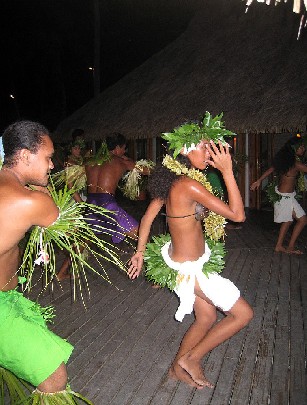
Tuamotu is an island group of French Polynesia, lying northeast of Tahiti. This archipelago consist of 80 atolls and covers a distance of about 870 miles with a significant portion "off limits" due to the aftermath of nuclear testing. So far the French have detonated 160 nuclear weapons in this fragile coral ecosystem, with the last being in1996. The US gave up testing in the South Pacific in the late 1950's after detonating 20 devices. Our plans were to steer far west to avoid the radioactive atolls, so we sailed for Rangiroa, one of the more popular cruiser destinations. Rangiroa is the second largest atoll in the world, second only to Kwajalein in the Marshall Islands.
So, what is an atoll? Darwin first theorized that atolls began as fringing reefs around volcanic islands. When the volcano stopped erupting, and the island began to sink it would leave a fringing reef which would eventually become a barrier reef. Over time, coral growth at the reef’s outer edge would push the top of the reef above the water and only the atoll would remain. Some of the atolls in the Tuamotu's have openings to the sea large enough to allow boats to enter but these openings usually have strong tidal currents associated with them.
When we departed on our four day sail from the Marquesas we had good winds in the 20 knot range although the seas were a bit lumpy. Our plan was to leave before the "reinforced trade winds" arrived. However the weatherman was a bit off and the next four days became a broadening experience. The winds continued to pick up during the first day and the sea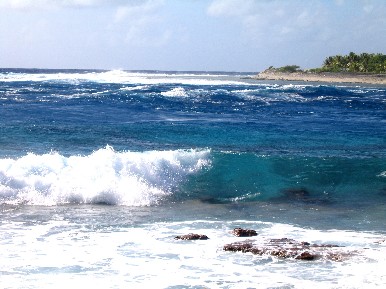 s were building and on the beam. Over the next three days we reefed and trimmed every sail and still averaged 7 knots. We were peppered with squalls (especially at night) carrying gust of 35 knots or more making it necessary to hand steer running ahead of the bad weather but never outrunning it. Finally we carried no main sail and only a small foresail and still the boat was going faster than 6.5 knots which is no big deal but the seas were around 9 to 12 feet. We "hove to" 35 miles off the entrance to the atoll and spent seven hours in high seas from the southeast and winds from the northeast so that the waves were crashing near the beam. Later that evening we again got underway with just a bit of head sail and arrived at the cut an hour before we wanted but that was not a problem. The problem was the cut itself which was not protected and the seas at 7 to 9 feet were pouring into the cut along with 25 knots of wind. What was suppose to be slack tide looked more like a washing machine. As we took the boat through it pitched and yawled but we added a bit more power and ten minutes later we were in. Later on the radio net we heard from the other boats that we were sailing with and they decided to forgo the atoll experience altogether and head directly for Tahiti, which is some 200 miles away. For cruisers that are reading this and are going to the Rangiroa be sure to hit the pass at slack water time and it appears that high tide was better than low tide. Also be aware when looking at the tide charts that there are several Rangiroas so be sure to look at the chart for the one in the Tuamotu. s were building and on the beam. Over the next three days we reefed and trimmed every sail and still averaged 7 knots. We were peppered with squalls (especially at night) carrying gust of 35 knots or more making it necessary to hand steer running ahead of the bad weather but never outrunning it. Finally we carried no main sail and only a small foresail and still the boat was going faster than 6.5 knots which is no big deal but the seas were around 9 to 12 feet. We "hove to" 35 miles off the entrance to the atoll and spent seven hours in high seas from the southeast and winds from the northeast so that the waves were crashing near the beam. Later that evening we again got underway with just a bit of head sail and arrived at the cut an hour before we wanted but that was not a problem. The problem was the cut itself which was not protected and the seas at 7 to 9 feet were pouring into the cut along with 25 knots of wind. What was suppose to be slack tide looked more like a washing machine. As we took the boat through it pitched and yawled but we added a bit more power and ten minutes later we were in. Later on the radio net we heard from the other boats that we were sailing with and they decided to forgo the atoll experience altogether and head directly for Tahiti, which is some 200 miles away. For cruisers that are reading this and are going to the Rangiroa be sure to hit the pass at slack water time and it appears that high tide was better than low tide. Also be aware when looking at the tide charts that there are several Rangiroas so be sure to look at the chart for the one in the Tuamotu.
We anchored off the Kia Ora Village Resort but before we could begin to explore this delightful little island and the surrounding waters, we needed to repair a leak in o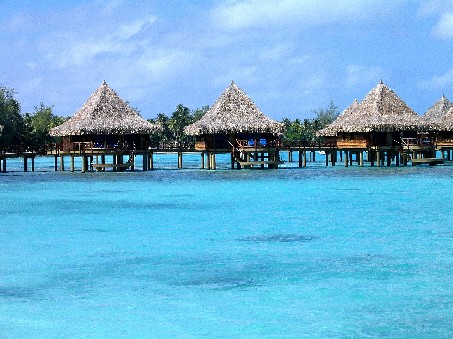 ur refrigeration system. This was accomplished in just a few days despite the need to fly in an isolation vibration part from Tahiti. With ice now back on the boat we really started to kick back and relax. The hotel is the center of activity and two or three flights come in several times a week carrying visitors to this beautiful destination resort. Some of the more expensive rooms extend out over the water as they do in many Polynesian resorts. This provides a beautiful setting where you can actually swim right off your hotel room, all for only $650.00 a night. In the hotel bar a Mi Tai cost $14.00. Hell, you can swim off my hotel room and we'll make you a Mi Tai for less than a dollar. Visiting Shiraz is a real bargain. On Wednesday and Sunday nights the hotel offers a buffet dinner for $50 per person and a troupe of locals put on an authentic Polynesian dance. We skipped the dinner but did go to the bar to watch the dance. Click here if you would like to see a short video of the dance troupe...remember, if you are on company time to turn down the sound........ ur refrigeration system. This was accomplished in just a few days despite the need to fly in an isolation vibration part from Tahiti. With ice now back on the boat we really started to kick back and relax. The hotel is the center of activity and two or three flights come in several times a week carrying visitors to this beautiful destination resort. Some of the more expensive rooms extend out over the water as they do in many Polynesian resorts. This provides a beautiful setting where you can actually swim right off your hotel room, all for only $650.00 a night. In the hotel bar a Mi Tai cost $14.00. Hell, you can swim off my hotel room and we'll make you a Mi Tai for less than a dollar. Visiting Shiraz is a real bargain. On Wednesday and Sunday nights the hotel offers a buffet dinner for $50 per person and a troupe of locals put on an authentic Polynesian dance. We skipped the dinner but did go to the bar to watch the dance. Click here if you would like to see a short video of the dance troupe...remember, if you are on company time to turn down the sound........
Click here for movie 
In an area called the " Aquarium", not far from our boat, is the most amazing collection of fish. Even with some current the snorkeling is exceptional and it is hard to imagine but the variety and color of the reef fish surpasses the Caribbean (maybe as a result of the nuclear testing?). After a couple of snorkels you even start to ignore the black tipped and white tipped sharks you spot, many times in three feet of water. On the first few snorkels we believe they gave us a wide birth because we had fouled the water around us with shark repellant (that is to say we peed our pants because they came so close). There are three dive shops located nearby and we signed up to dive the wall outside of the cut. Higher currents attract larger fish including an 80 pound yellow fin tuna along with a number of sharks.
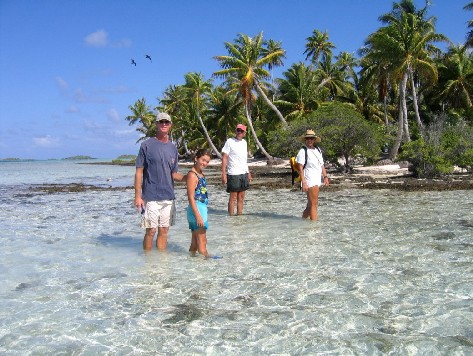
The atoll is so large that within it there are many anchoring sites within a days sail. Accompanied with friends on S/V Sensai, we traveled to the leeward side of the atoll to an area called the "blue lagoon", about 20 miles away. Anchoring was a problem but we were finally able to find a spot without too many coral heads to snag our chain. The next morning we found our way through the reef and anchored our dinghy in about one foot of water. From here we walk to the lagoon. There is an abundance of small black tipped sharks and sea cucumbers to step around but when you arrive you find the lagoon that is in fact an incredible blue. Day trippers come over by motor launch and spend the day in the lagoon swimming and picnicking before heading back to the resorts and pensions. After our morning excursion to the lagoon we hauled the anchor and motor/sailed back to the windward side of the lagoon to a familiar calm anchorage. We will probably stay in Rangaroia another week to explore a little more and then head to Tahiti for the celebration of Bastille Day, July 16th. We think that holds some interest for us so for now that is our plan.
More to come once we reach Tahiti.
More photos, please click the arrow to start the slide show and the square to stop the slide show.
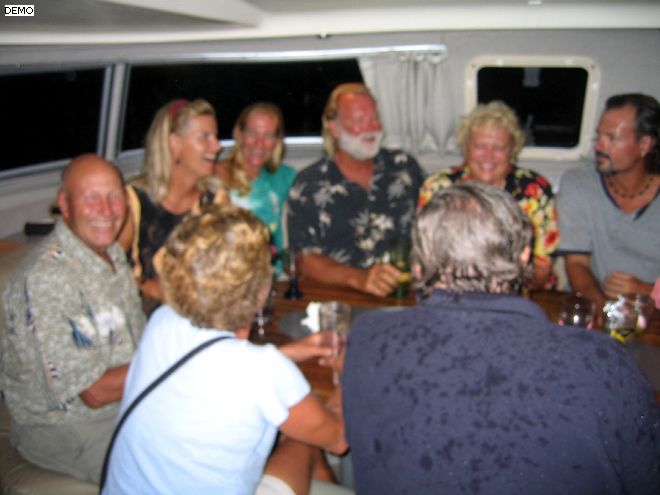
| |
  
|
It's raining on our party
|
If you're headed that way:
- Again a radio net was organized to assist boats that were undertaking the 600 miles trip to the Tuamotu and beyond. The name was changed to the "coconut net" and the frequency and the format were changed. At this time the frequency is 6510.
- With a population of around 300 in Rangiroa, you can still find about any service needed. An excellent source of information is Sara a US expatriate working at Daniels the major store in the village. She recommended Temarii (tel 71 21 22) to work on our refrigeration and he was very proficient.
- We discovered a new guide. The Guide of Navigation and Tourism in French Polynesia by Bonnette and Deschamps is one of the best we have seen. We would highly recommend it.
- It is unfortunate but boat items still come up missing according to the reports on the net. Whether locals or yauchties may be to blame it is still important to lock everything above deck at all times and especially remember to lock your dinghy.
- We cannot overemphasize the economic benefit of provisioning well in a lower cost area before traveling to French Polynesia.
Back Next
|